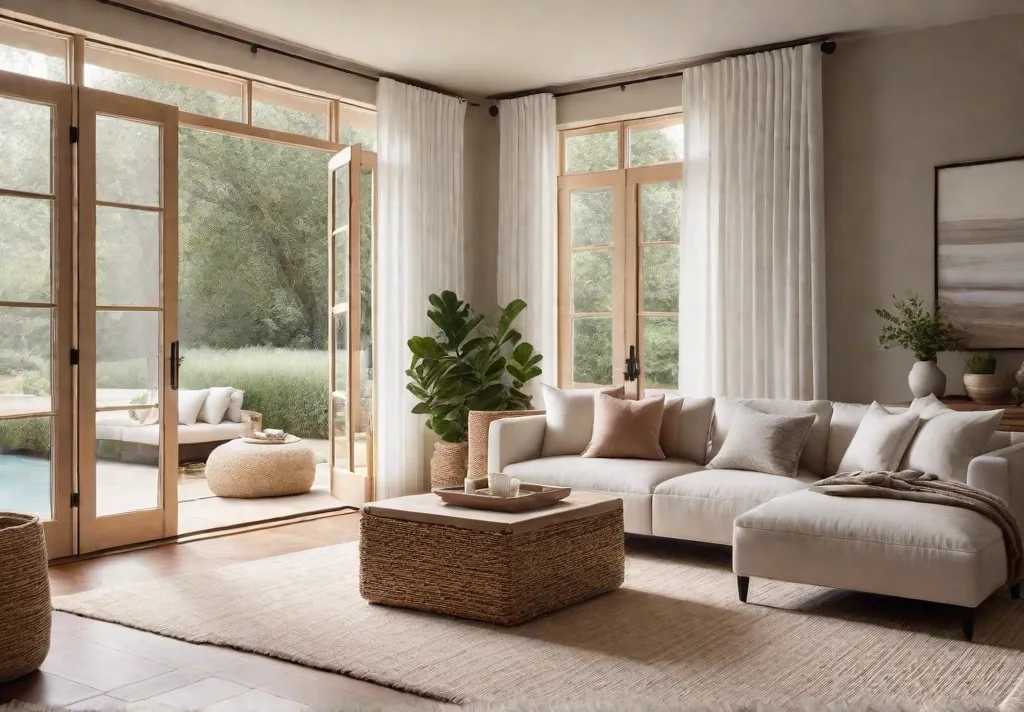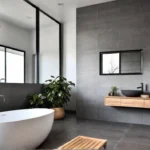My dear friends, as I gaze around my cozy living room, I’m reminded of the simple joys in life – a warm cup of tea, the crackle of the fire, and the inviting textures that envelop me in pure comfort. Texture is the unsung hero of interior design, weaving together elements to create a space that feels like a warm embrace.
Today, I invite you to join me on a journey through the world of texture, where we’ll unravel its secrets and learn how to infuse our homes with depth, dimension, and undeniable charm. Each material has a story, from plush velvets to nubby wools, and I can’t wait to share it with you. So settle in, grab your favorite throw, and let’s discover the transformative power of texture together.
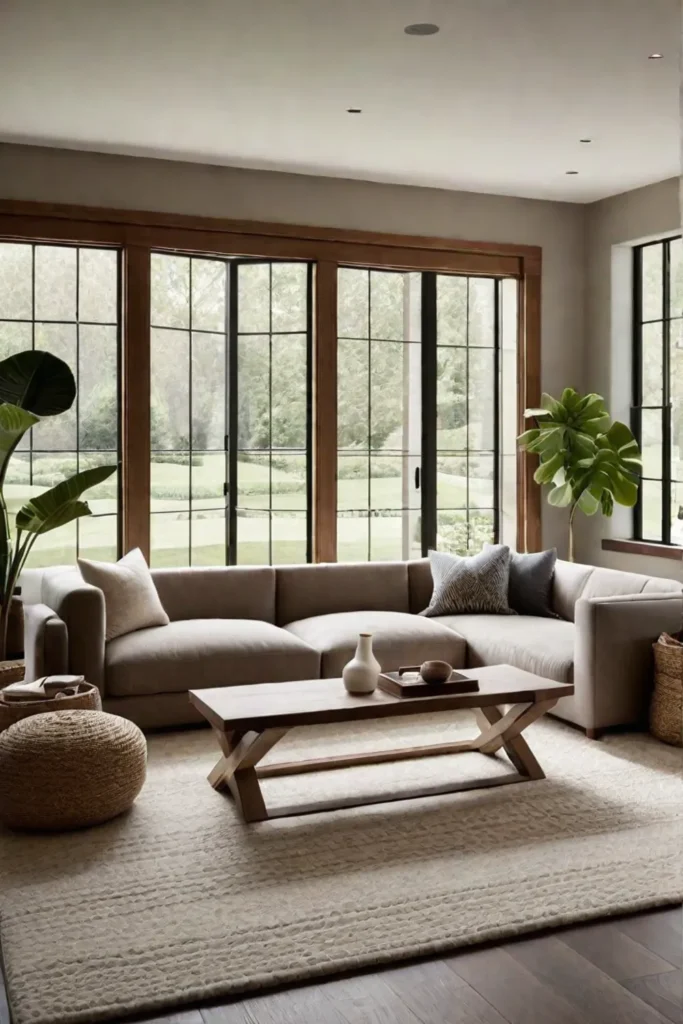
Understanding Texture in Interior Design
As an interior design enthusiast, I can’t emphasize enough the importance of texture in creating a cozy and inviting living space. Texture adds depth, visual interest, and tactile appeal that can instantly elevate a room’s overall ambiance.
Types of Textures
Let’s start by exploring the different textures you can incorporate into your living room. The possibilities are endless, from smooth and silky fabrics like satin and velvet to rough and nubby materials like wool and jute. You can also play with contrasting textures, such as pairing a sleek leather sofa with a chunky knit throw blanket.
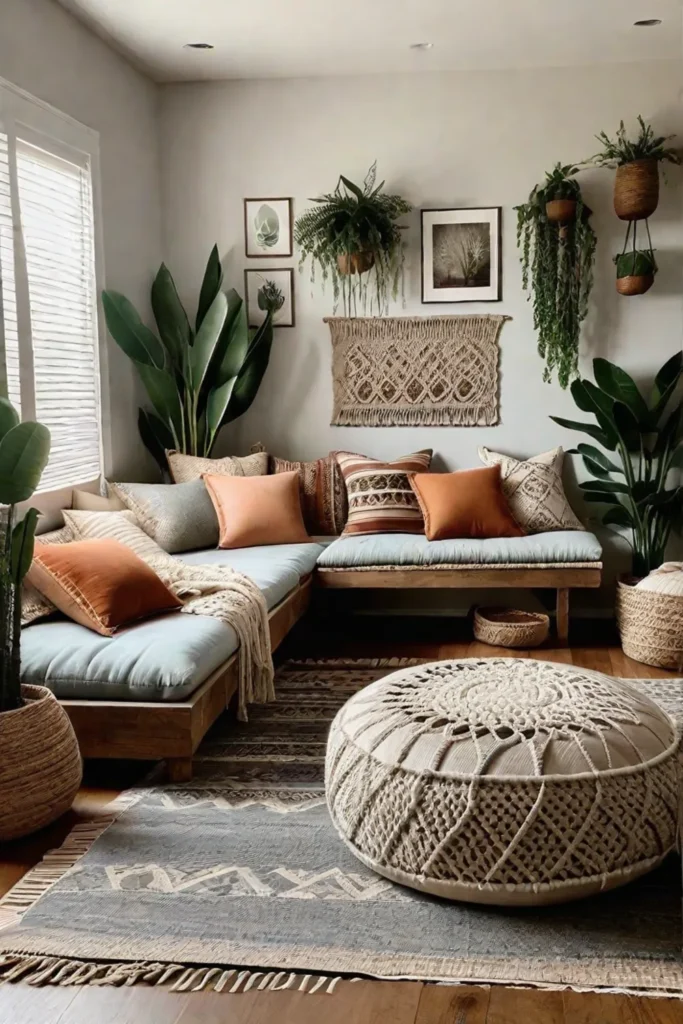
The Impact of Texture on Mood
Did you know that different textures can evoke various emotions and moods? It’s true! Soft, plush textures create a sense of warmth and comfort, while rougher textures like exposed brick or stone can add a rustic, earthy vibe. Natural textures, like wood and stone, are known for their calming and grounding effects, making them perfect for creating a serene and relaxing atmosphere.
Practical Tips
Here are some practical tips to help you incorporate texture into your living room:
- Use a variety of textures, from smooth and shiny to rough and nubby, to create a balanced and inviting space.
- When selecting textiles, consider the room’s existing architectural elements and furniture. You want to create a cohesive look that ties everything together.
- Texture can manipulate the perception of space, making a room feel larger or cozier. For example, using plush, heavy fabrics can make a room feel more intimate and comfortable.
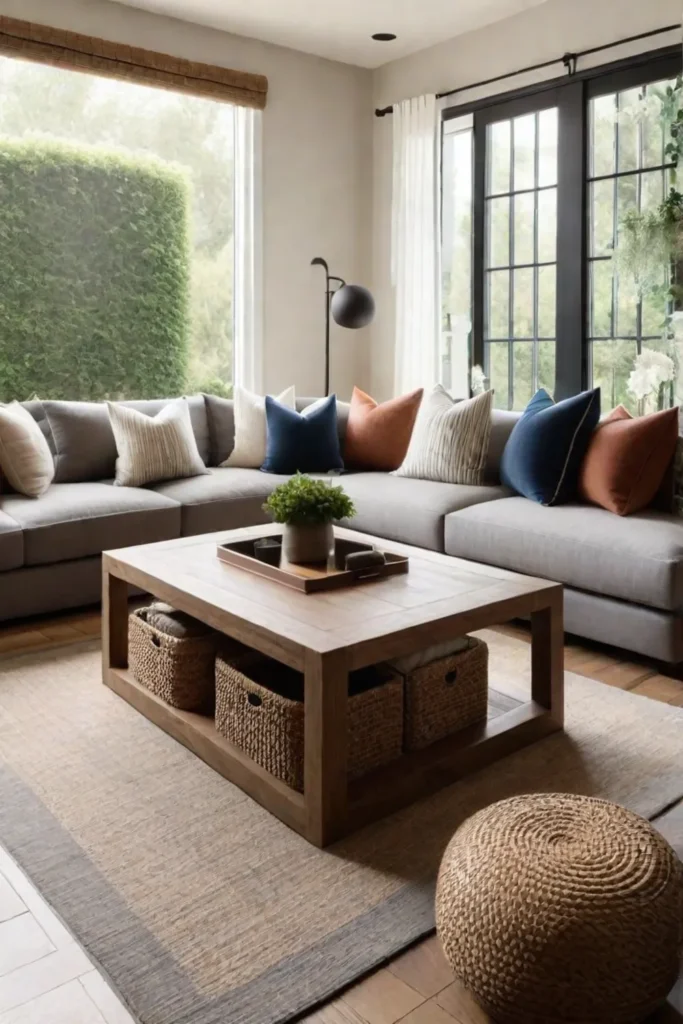
Answering Your Questions
Now, let’s address some of your questions:
How do different cultures use texture in interior design?
Different cultures have their unique approaches to incorporating texture into their living spaces. For example, in Japanese design, natural textures like wood, bamboo, and stone are highly valued for their simplicity and connection to nature. Middle Eastern design often features intricate patterns and textures in textiles, such as embroidered fabrics and ornate rugs.
What are the latest trends in textured home decor?
One of the latest trends in textured home decor is using natural, organic materials like rattan, jute, and macramé. These materials add visual interest and bring a sense of warmth and connection to nature into the space. Additionally, textured wallpapers and wall coverings are becoming increasingly popular, allowing you to add depth and dimension to your walls.
Key Takeaways
Texture is an essential element of interior design that can significantly impact the look and feel of a living room. Understanding the different types of textures and their effects can help you create a stylish and comfortable space. By incorporating a variety of textures and following practical tips, you can transform your living room into a cozy and inviting haven.

The next section will focus on the essential textured elements to help you achieve that cozy vibe: throw pillows, rugs, and blankets.
Essential Textured Elements: Throw Pillows, Rugs, and Blankets
As an interior design enthusiast, I can’t emphasize enough the power of textured elements in creating a cozy and inviting living room. These small additions can transform a space, making it feel warm, personal, and oh-so-comfortable.
Throw Pillow Play: Mixing and Matching
Throw pillows are the ultimate accessory for adding pops of color, pattern, and texture to your sofas and chairs. I love to mix and match different textures like velvet, linen, and faux fur for a luxurious feel. Don’t be afraid to experiment – combining contrasting textures can create a visually stunning and tactile experience.

Rugs: Grounding the Space
Rugs are more than just floor coverings; they’re essential for defining spaces and anchoring furniture. A well-chosen rug can add warmth underfoot and be the foundation for your room’s color scheme and texture palette. Consider a handwoven rug with intricate designs – these pieces are true works of art that can take months or even years to create.
Blankets: Adding Warmth and Comfort
Blankets are the epitome of coziness and a must-have for any living room. Drape them over your sofa or armchair for an inviting, casual look, and layer them with different textures and weights for added visual interest. From chunky knits to soft fleece, blankets offer endless opportunities to add warmth and comfort to your space.
When it comes to throw pillows, durability and comfort are key. Look for high-quality materials like cotton, linen, or velvet – they’ll hold up well over time and feel luxurious against your skin. As for rugs, measure your living room carefully and choose a size that leaves enough walkway space while still anchoring your furniture. A general rule of thumb is to ensure that the front legs of your sofa and chairs rest on the rug.

Remember, texture is the secret ingredient transforming a living room from ordinary to extraordinary. So, embrace those throw pillows, rugs, and blankets, and let your creativity run wild!
The foundation of any cozy living room lies in the upholstery fabrics you choose for your furniture…
Upholstery Fabrics: The Foundation of Texture
As an interior design enthusiast, I can’t emphasize enough the impact that upholstery fabrics have on your living room furniture’s overall texture and style. These fabrics aren’t just about aesthetics; they also play a crucial role in determining your pieces’ durability, comfort, and maintenance requirements.

Popular Upholstery Fabrics and Their Textures
Let’s dive into some of the most popular upholstery fabric options and their unique textures. Leather, for instance, has been a timeless choice for centuries, offering a rich, supple feel and unparalleled durability. Once a luxury reserved for royalty, Velvet adds an opulent touch with its plush, smooth texture. Cotton and linen blend provides a breathable, relaxed vibe with a natural, slightly textured feel. And let’s not forget microfiber – a synthetic option that’s incredibly soft and easy to maintain.
Choosing the Right Upholstery Fabric for Your Lifestyle
When selecting upholstery fabrics, consider your lifestyle and the level of use your furniture will endure. For high-traffic areas, opt for durable options like microfiber or leather, which can withstand daily wear and tear. If you’re aiming for a more relaxed atmosphere, linen and cotton blends offer a soft, inviting touch. And don’t forget to factor in maintenance—some fabrics are easier to clean than others.

Pros and Cons of Natural vs. Synthetic Upholstery Fabrics
Natural fabrics like cotton and linen are breathable and environmentally friendly but can be more prone to staining and wear. Synthetic options like microfiber and polyester, on the other hand, are often more durable and easier to clean. Still, they may not offer the same comfort and breathability as natural fibers.
Cleaning and Maintaining Upholstery Fabrics
Proper cleaning and maintenance are key to keeping your upholstery looking its best. Regular vacuuming and spot cleaning with mild detergents for natural fabrics can help prevent buildup. Leather requires occasional conditioning to maintain its suppleness. And for synthetic fabrics, a simple damp cloth or upholstery cleaner can work wonders in removing dirt and stains.
Remember, the choice of upholstery fabric sets the foundation for your living room’s texture and overall aesthetic. Take the time to explore your options and select fabrics that look beautiful and align with your lifestyle and maintenance preferences.

Layering textiles is the next step in creating a cozy, inviting living space. Combining different fabrics can add depth and dimension to your decor, creating a truly inviting atmosphere.
Layering Textiles for Depth and Dimension
As an interior designer, I firmly believe that layering textiles is the secret sauce to creating a cozy and inviting living room. It’s all about adding depth, dimension, and visual interest to the space.
The Art of Layering: Tips and Techniques
The key to successful layering is striking the perfect balance. You want to create a harmonious blend of textures without overwhelming the room. Start with a neutral base, like a cozy rug or a plush sofa, and then build layers of texture with pillows, throws, and curtains. Don’t be afraid to mix and match patterns, but make sure they complement each other.

Creating a Cohesive Look with Layered Textures
Cohesion is crucial when layering textiles. While you want to create visual interest, you don’t like the space to look like a jumble of random elements. Please choose a color palette and stick to it, or opt for a unifying theme, like a coastal or bohemian vibe. This will help tie all the textures together and create a harmonious, well-designed space.
Layering for Focal Points and Visual Interest
One of the best ways to use layering is to create focal points in your living room. Arrange your textiles in a way that draws the eye to a specific area, like a cozy reading nook or a statement fireplace. You can also use layering to create visual interest by playing with scale and pattern. Mix large-scale prints with smaller, more intricate designs for a dynamic, engaging look.
Avoid common mistakes like overloading the space with too many textures or using clashing patterns that don’t work well together. Remember, less is often more when it comes to layering textiles.

The key takeaways? Layering textiles is an effective way to add depth, dimension, and personality to your living room. By following simple tips and techniques, you can create a layered look that is both stylish and inviting. Trust me, your guests will swoon over your cozy and curated space.
Beyond the basic textiles, you can incorporate plenty of other textural elements into your living room design. Let’s explore those in the next section.
Beyond the Basics: Exploring Additional Textural Elements
As an interior design enthusiast, creating a cozy living room goes beyond just layering textiles. To achieve a warm and inviting ambiance, we must explore additional textural elements that elevate the overall design.

Walls: Textured Finishes and Wall Art
Walls are often overlooked in texture, but they offer a fantastic opportunity to add depth and interest to your living room. Consider using a textured paint finish or wallpaper to mimic the look of natural materials, such as brick or stone. Alternatively, you can incorporate wall art with raised or embossed designs to create a tactile experience.
Window Treatments: Adding Softness and Light Control
Window treatments not only control light but also contribute to the overall texture of the room. Choose curtains or blinds with a subtle texture or pattern to complement the other textiles in the room. Sheer curtains can add a soft, flowing element, while heavier drapes can provide a cozy, enveloping feel.

Decorative Accessories: The Finishing Touches
Decorative accessories are the finishing touches that can tie the textural elements together. Incorporate woven baskets, ceramic vases, or sculptures to add visual interest and tactile appeal. These pieces can also introduce natural elements, such as wood or stone, adding an organic texture and a sense of warmth to the space.
Exploring these additional textural elements can elevate the design of your living room, creating a space that is not only visually appealing but also inviting and comforting. Remember, texture is not just about what you see but also about your feelings.
Conclusion
As we bid farewell to our exploration of texture, I hope you feel inspired to embrace its magic within your living spaces. Remember, true coziness isn’t found in a catalog or showroom – it’s cultivated through the thoughtful layering of textures that speak to your soul.

So go forth, my friends, and let your creativity run wild. Mix and match fabrics, experiment with unexpected combinations, and trust your instincts. In the end, the most beautiful homes reflect the warmth and individuality of the hearts that dwell within them.
Texture is the heartbeat of a welcoming home, and I can’t wait to see how you’ll make it your own. Until next time, may your living room be a sanctuary of comfort, where cherished memories are made, and life’s simple pleasures are savored?
